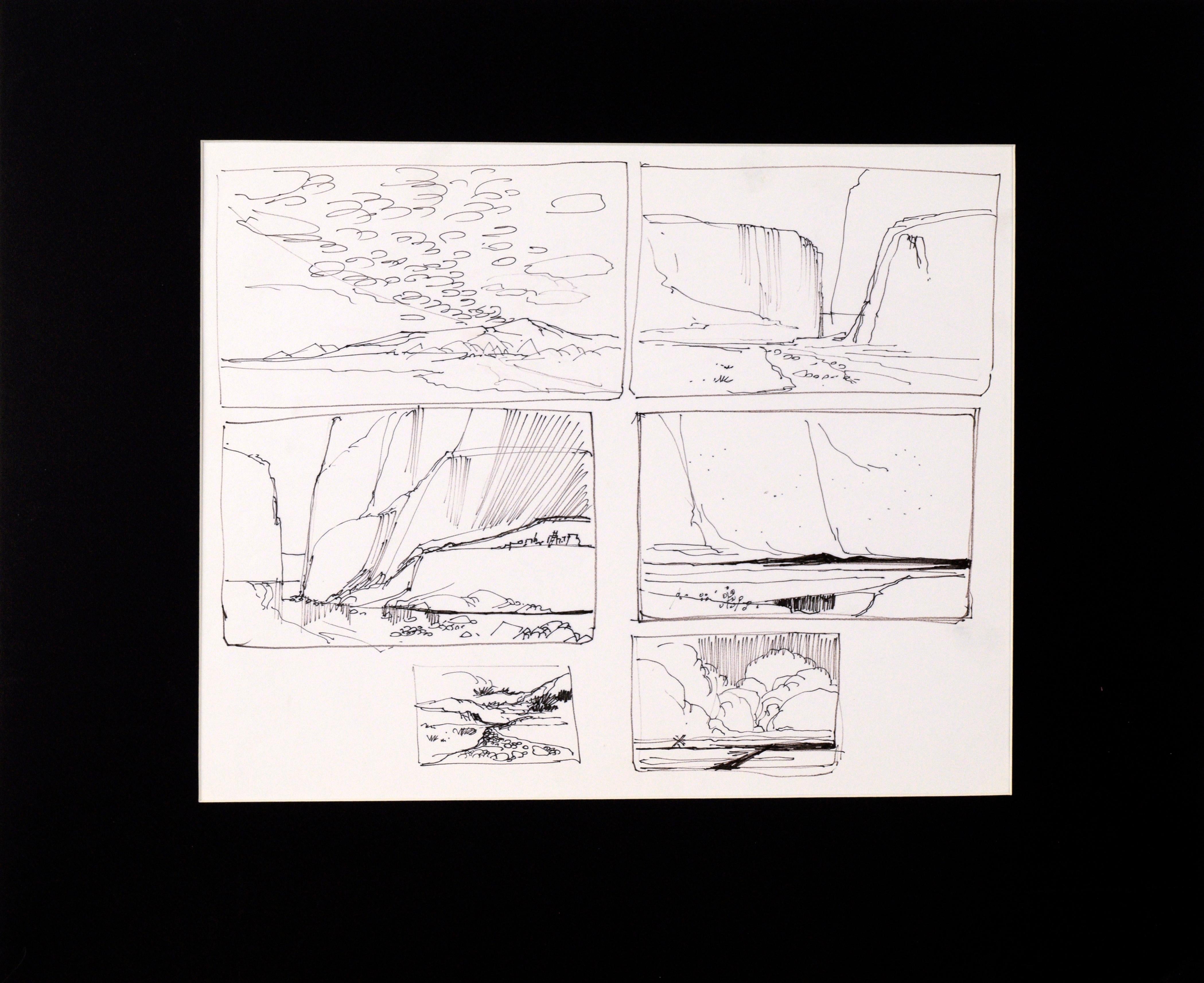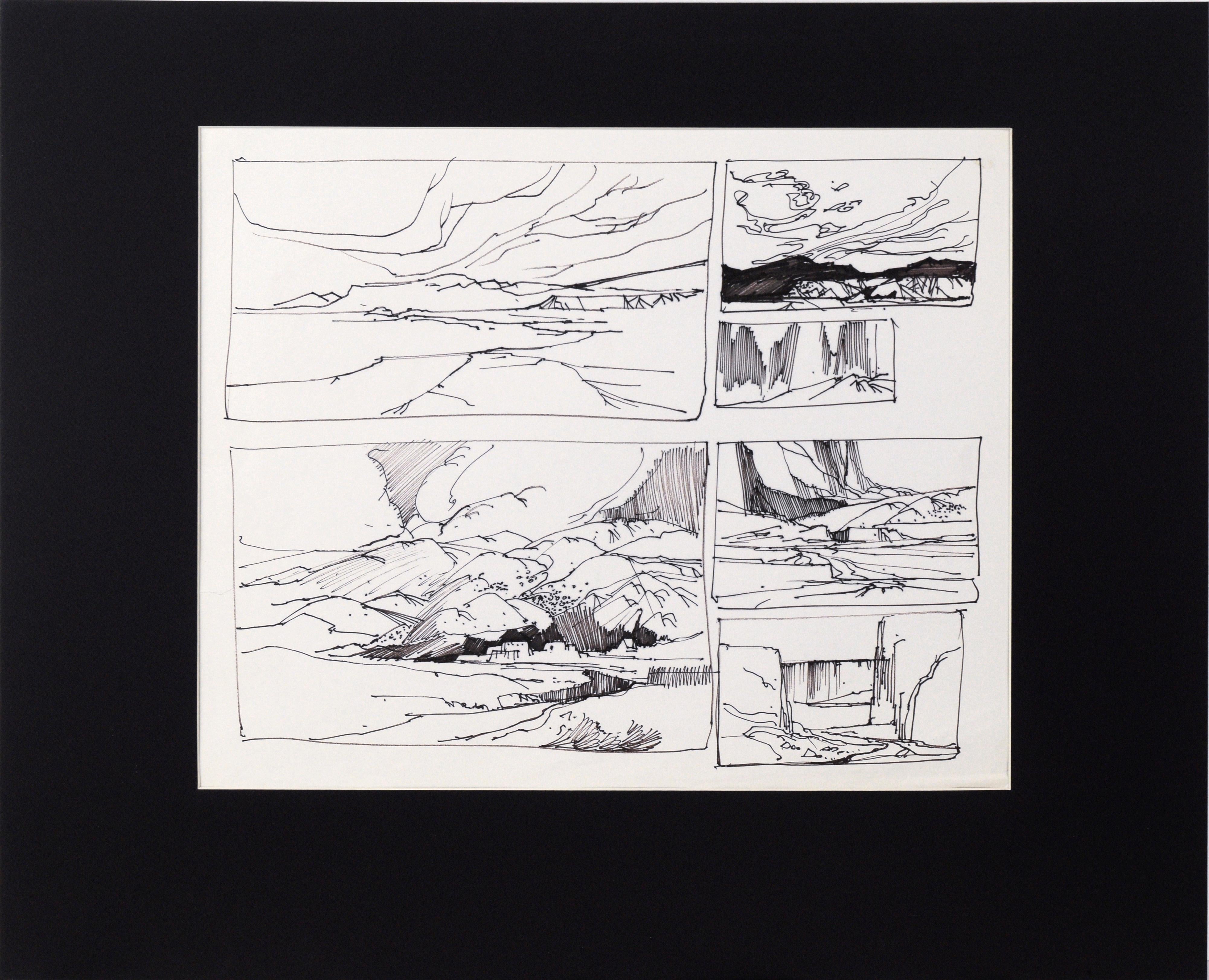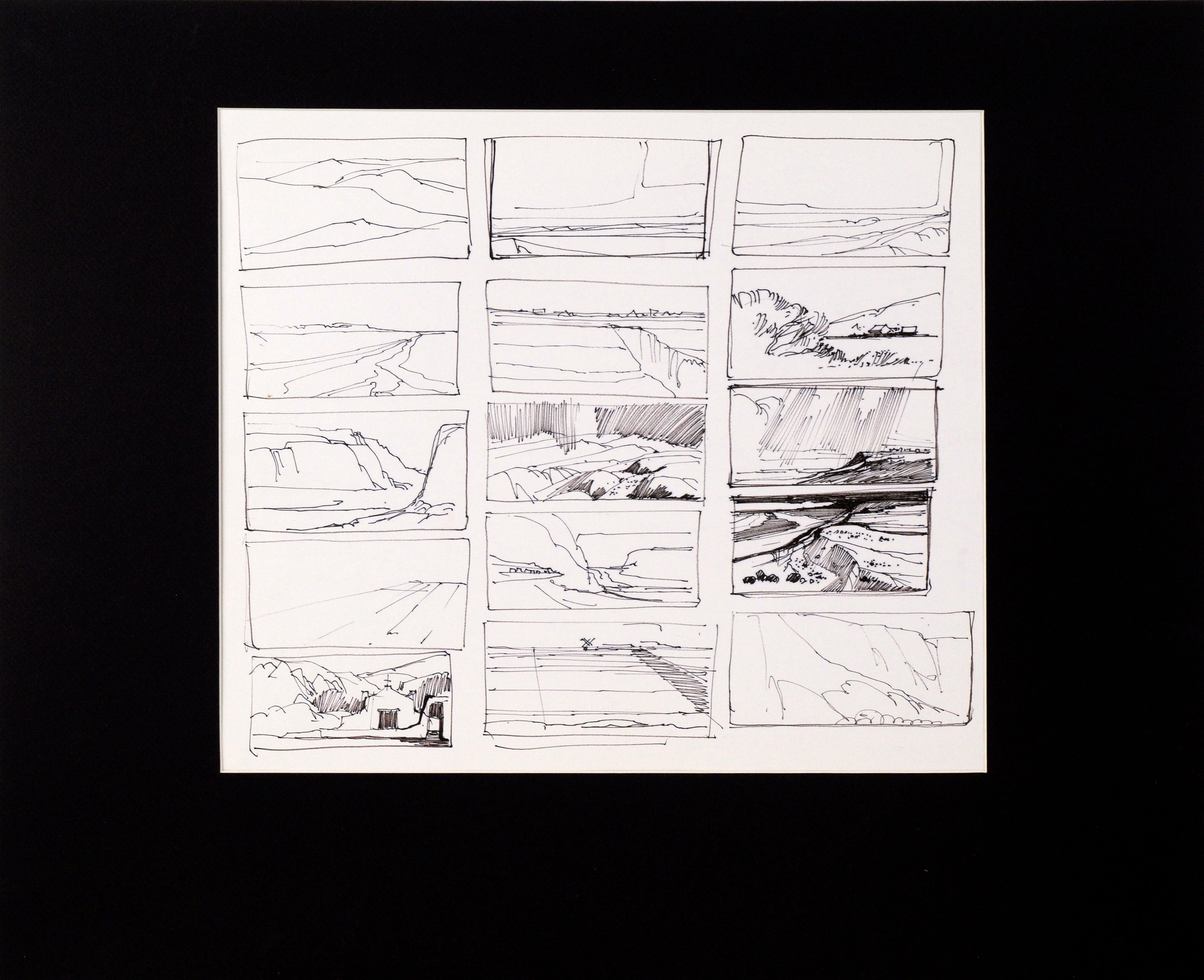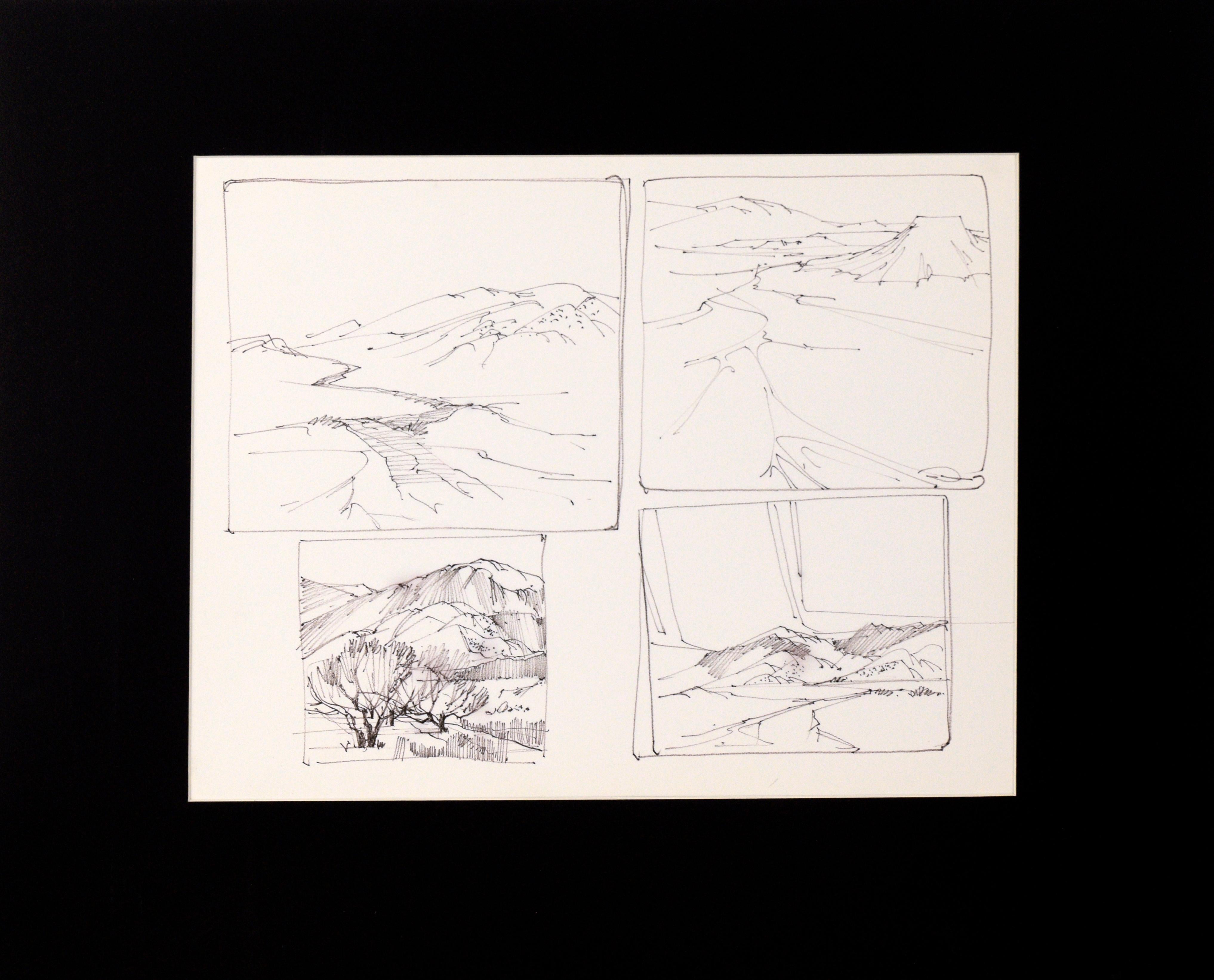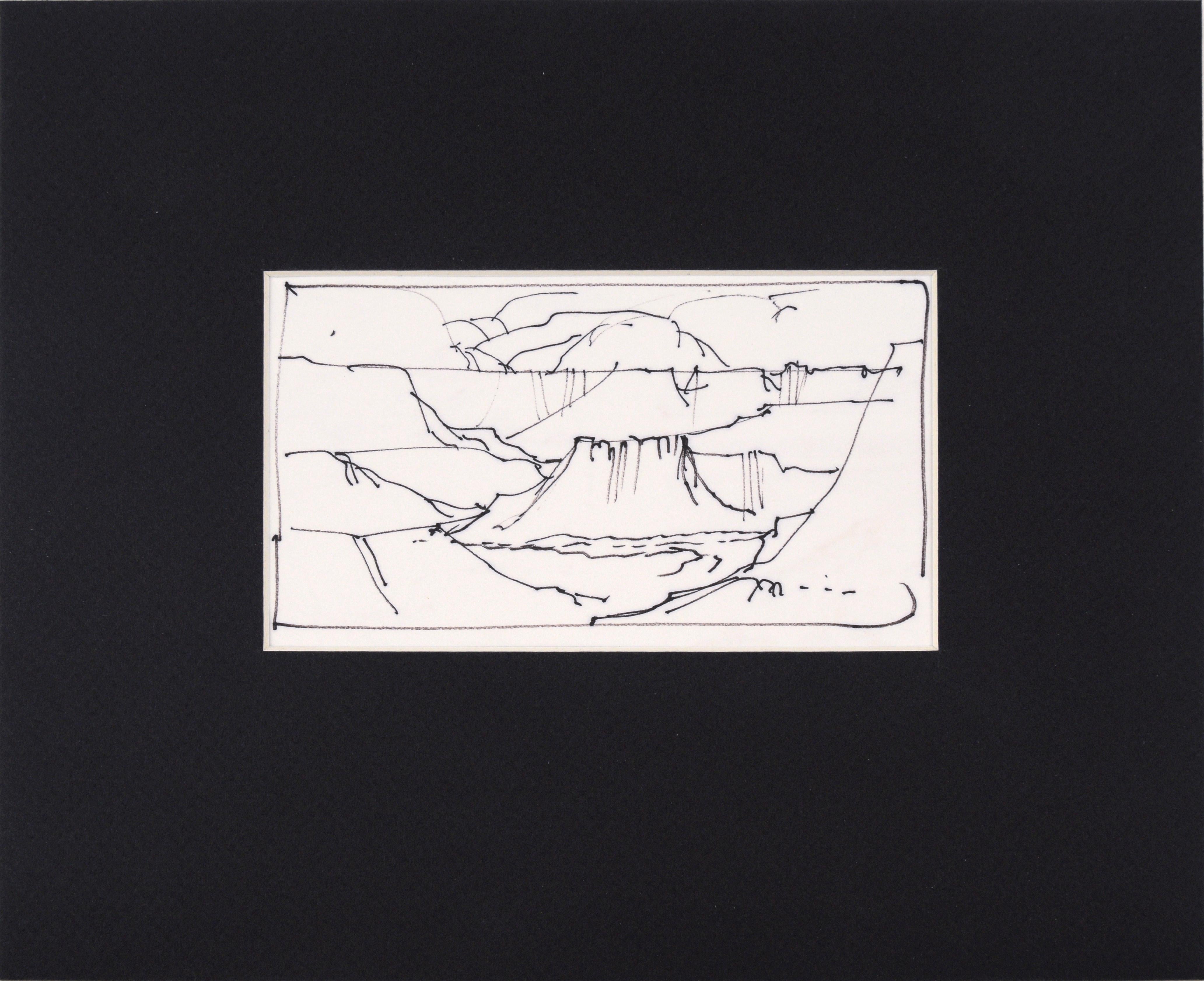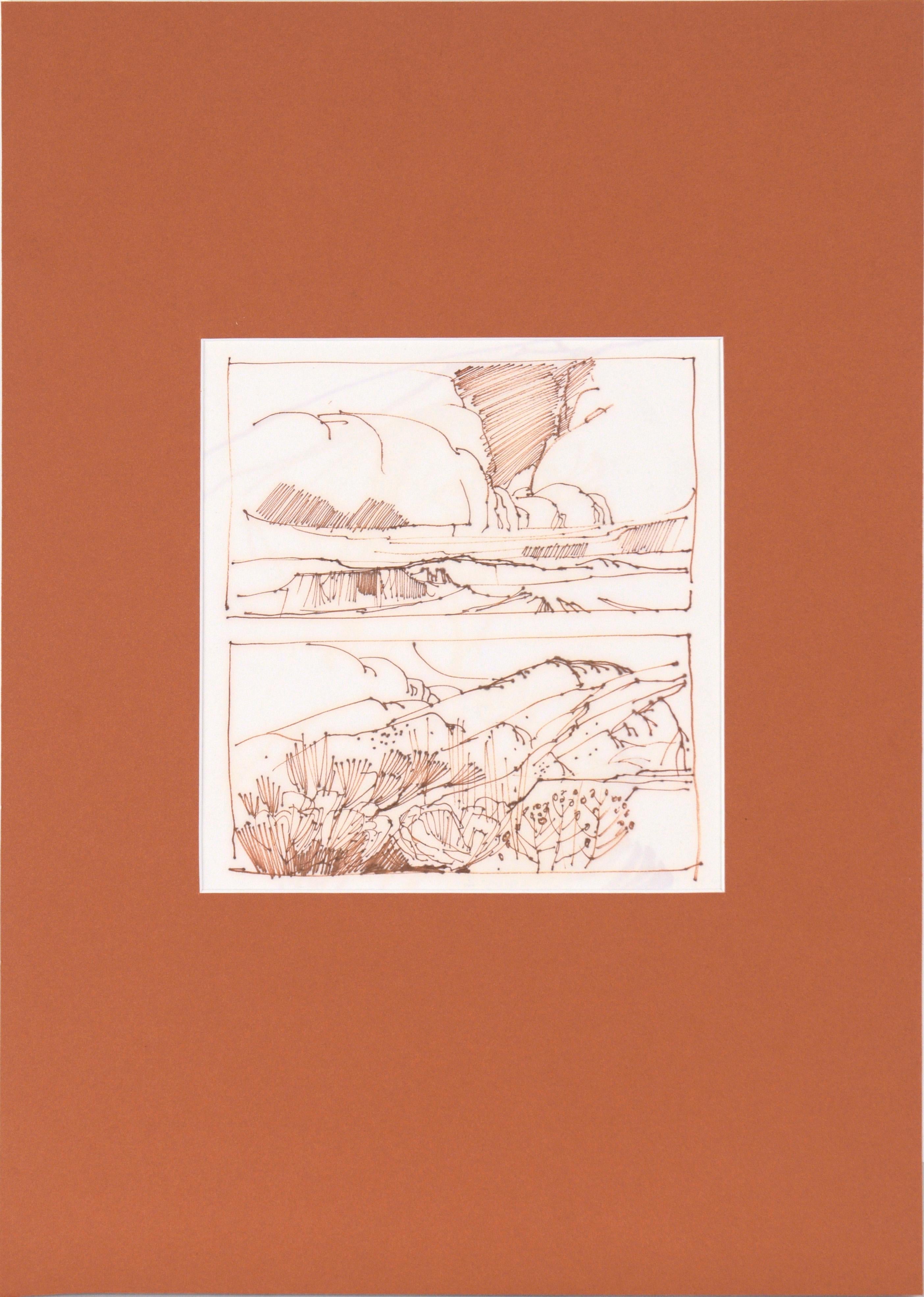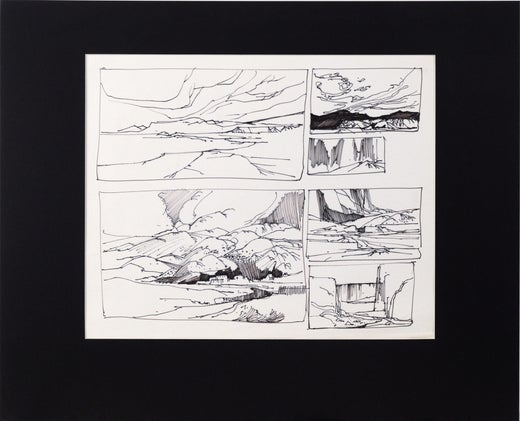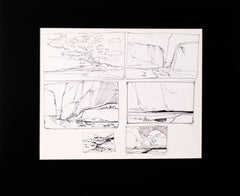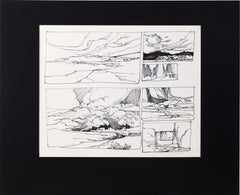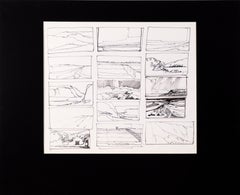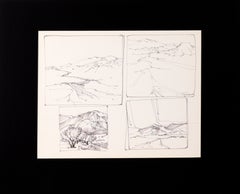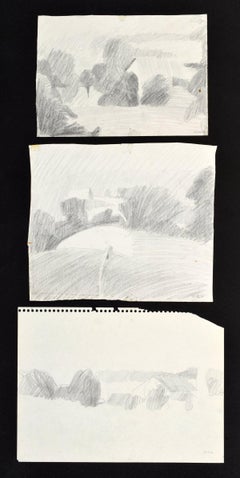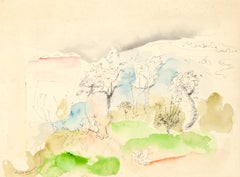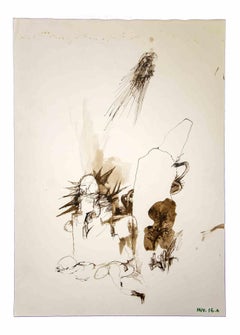Items Similar to Five-Panel Thumbnail Sketches of Desert and Canyon Landscapes in Ink on Paper
Want more images or videos?
Request additional images or videos from the seller
1 of 12
Laurence SissonFive-Panel Thumbnail Sketches of Desert and Canyon Landscapes in Ink on Paperlate 20th Century
late 20th Century
$1,650
£1,253.31
€1,444.24
CA$2,323.61
A$2,576.06
CHF 1,353.82
MX$31,526.80
NOK 16,907.86
SEK 15,869.72
DKK 10,780.34
About the Item
Five-Panel Thumbnail Sketches of Desert and Canyon Landscapes in Ink on Paper
Collection of landscape line drawings by listed Maine artist Laurence Sisson (American, 1928-2015). Five panels of preparatory drawings for landscape paintings are laid out across the page. There are various scenes of desert blossoms, foothills, canyons, and mesas, with dramatic clouds overhead, and an expansive sun. Of particular not is Sisson's confident shading, creating layers of depth in the compositions.
This piece is unsigned, but was acquired from David Sisson, the artist's son, with his initial "DL" on verso, authenticating the work as by Laurence Sisson.
Presented in a new black mat with foam-core backing.
Mat size: 20"H x 20"W
Paper size: 14"H x 17"W
Laurence Sisson, was a student of Herbert Barnett (1910-1972), he was one of America's preeminent realist painters today. His work may be found in the permanent collections of museums nationwide including the Museum of Fine Arts, Boston, and the Portland Museum of Art, Maine.
Laurence Sisson painted landscapes for sixty years. He was known for his paintings of the Maine coast and landscapes of the southwest. His style ranges from plein air watercolors to large oil landscapes with abstract and surrealist elements. Laurence Sisson spent 50 years living in both areas of the United States yet he notes the most influential place for his artistic development was the time he spent in Japan as a young man.
Laurence Sisson was been a talented painter as a child and attended art classes at the Worcester Art museum in Massachusetts. Sisson painted professionally while in his early twenties though he had not decided to devote his life to art. While serving in the military during the United States occupation of Japan after War World II he was assigned to decorate the general's residence in Yokohama. This assignment forced him to learn all he could about the land and culture of Japan and by the time he left he was changed as an artist and man.
Sisson describes this period of his painting as when he began "designing nature." His work appears to be a response to traditional Asian landscape painting, his Yankee sensibility and western art training at Yale summer school. His landscapes of both Maine and the southwest are inspired by real locations, but are in fact imaginary landscapes.
Sisson was the youngest member of the Watercolor Society of America.
- Creator:Laurence Sisson (1928, American)
- Creation Year:late 20th Century
- Dimensions:Height: 20 in (50.8 cm)Width: 20 in (50.8 cm)Depth: 0.25 in (6.35 mm)
- Medium:
- Movement & Style:
- Period:
- Condition:Artwork is in very good condition with some wrinkling around edges of paper, though hidden by the mat. Mat is new.
- Gallery Location:Soquel, CA
- Reference Number:Seller: ANS85981stDibs: LU54212318382
Laurence Sisson
Laurence Sisson, was a student of Herbert Barnett (1910-1972), he was one of America's preeminent realist painters today. His work may be found in the permanent collections of museums nationwide including the Museum of Fine Arts, Boston, and the Portland Museum of Art, Maine. Laurence Sisson painted landscapes for sixty years. He was known for his paintings of the Maine coast and landscapes of the southwest. His style ranges from plein air watercolors to large oil landscapes with abstract and surrealist elements. Laurence Sisson spent 50 years living in both areas of the United States yet he notes the most influential place for his artistic development was the time he spent in Japan as a young man. Laurence Sisson was been a talented painter as a child and attended art classes at the Worcester Art museum in Massachusetts. Sisson painted professionally while in his early twenties though he had not decided to devote his life to art. While serving in the military during the United States occupation of Japan after War World II he was assigned to decorate the general's residence in Yokohama. This assignment forced him to learn all he could about the land and culture of Japan and by the time he left he was changed as an artist and man. Sisson describes this period of his painting as when he began "designing nature." His work appears to be a response to traditional Asian landscape painting, his Yankee sensibility and western art training at Yale summer school. His landscapes of both Maine and the southwest are inspired by real locations, but are in fact imaginary landscapes. Sisson was the youngest member of the Watercolor Society of America.
About the Seller
5.0
Platinum Seller
Premium sellers with a 4.7+ rating and 24-hour response times
Established in 1986
1stDibs seller since 2014
2,989 sales on 1stDibs
Typical response time: <1 hour
- ShippingRetrieving quote...Shipping from: Soquel, CA
- Return Policy
Authenticity Guarantee
In the unlikely event there’s an issue with an item’s authenticity, contact us within 1 year for a full refund. DetailsMoney-Back Guarantee
If your item is not as described, is damaged in transit, or does not arrive, contact us within 7 days for a full refund. Details24-Hour Cancellation
You have a 24-hour grace period in which to reconsider your purchase, with no questions asked.Vetted Professional Sellers
Our world-class sellers must adhere to strict standards for service and quality, maintaining the integrity of our listings.Price-Match Guarantee
If you find that a seller listed the same item for a lower price elsewhere, we’ll match it.Trusted Global Delivery
Our best-in-class carrier network provides specialized shipping options worldwide, including custom delivery.More From This Seller
View AllSix-Panel Thumbnail Sketches of Desert and Canyon Landscapes in Ink on Paper
By Laurence Sisson
Located in Soquel, CA
Six-Panel Thumbnail Sketches of Desert and Canyon Landscapes in Ink on Paper
Collection of landscape line drawings by listed Maine artist Laurence Sisson (American, 1928-2015). Six ...
Category
Late 20th Century American Impressionist Landscape Drawings and Watercolors
Materials
Paper, Permanent Marker
Six Panel Thumbnail Sketches of Desert and Canyon Landscapes in Ink on Paper
By Laurence Sisson
Located in Soquel, CA
Six Panel Thumbnail Sketches of Desert and Canyon Landscapes in Ink on Paper
Collection of landscape line drawings by listed Maine artist Laurence Sisson (American, 1928-2015). Six ...
Category
Late 20th Century American Impressionist Landscape Drawings and Watercolors
Materials
Paper, Permanent Marker
Fifteen-Panel Thumbnail Sketches of Desert and Canyon Landscapes in Ink on Paper
By Laurence Sisson
Located in Soquel, CA
Fifteen-Panel Thumbnail Sketches of Desert and Canyon Landscapes in Ink on Paper
Collection of landscape line drawings by listed Maine artist Laurence Sisson (American, 1928-2015). ...
Category
Late 20th Century American Impressionist Landscape Drawings and Watercolors
Materials
Paper, Permanent Marker
Four-Panel Thumbnail Sketches of Desert and Canyon Landscapes in Ink on Paper
By Laurence Sisson
Located in Soquel, CA
Four-Panel Thumbnail Sketches of Desert and Canyon Landscapes in Ink on Paper
Collection of landscape line drawings by listed Maine artist Laurence Sisson (American, 1928-2015). Fou...
Category
Late 20th Century American Impressionist Landscape Drawings and Watercolors
Materials
Paper, Permanent Marker
Grand Canyon Plateau - Line Drawing Landscape in Ink on Paper
By Laurence Sisson
Located in Soquel, CA
Grand Canyon Plateau - Line Drawing Landscape in Ink on Paper
Bold landscape line drawing by listed Maine artist Laurence Sisson (American, 1928-2015). Towering canyon walls frame a river snaking round a central plateau. This drawing was likely a preparatory sketch for a larger painting.
This piece is unsigned, but was acquired from David Sisson, the artist's son. Copy of the letter of authentication included.
Presented in a new black mat with foam-core backing.
Mat size: 8"H x 10"W
Image size: 3.38"H x 6.63"W
Laurence Sisson, was a student of Herbert Barnett (1910-1972), he was one of America's preeminent realist painters today. His work may be found in the permanent collections of museums nationwide including the Museum of Fine Arts, Boston, and the Portland Museum of Art, Maine.
Laurence Sisson painted landscapes for sixty years. He was known for his paintings of the Maine coast and landscapes of the southwest. His style ranges from plein air watercolors to large oil landscapes...
Category
Late 20th Century American Impressionist Landscape Drawings and Watercolors
Materials
Paper, Permanent Marker
Two High Desert Landscapes - Line Drawing in Sepia-Toned Ink on Paper
By Laurence Sisson
Located in Soquel, CA
Two High Desert Landscapes - Line Drawing in Sepia-Toned Ink on Paper
Bold landscape line drawings by listed Maine artist Laurence Sisson (American, 1928-2015). In the top image, giant cumulous clouds hang over the desert plateaus of varying heights. In the bottom image, desert brush fill the foreground with rocky mountains and big clouds towering over. These drawings were likely preparatory sketches for larger paintings.
This piece is unsigned, but was acquired from David Sisson, the artist's son.
Copy of a signed letter of authentication included
Presented in a new orange mat with foam-core backing.
Mat size: 19"H x 13"W
Image size: 10.63"H x 7.75"W
Laurence Sisson, was a student of Herbert Barnett (1910-1972), he was one of America's preeminent realist painters today. His work may be found in the permanent collections of museums nationwide including the Museum of Fine Arts, Boston, and the Portland Museum of Art, Maine.
Laurence Sisson painted landscapes for sixty years. He was known for his paintings of the Maine coast and landscapes of the southwest. His style ranges from plein air watercolors to large oil landscapes...
Category
Late 20th Century American Impressionist Landscape Drawings and Watercolors
Materials
Paper, Permanent Marker
You May Also Like
3 William Clutz Landscape Drawings
By William Clutz
Located in Lake Worth Beach, FL
Artist/Designer; Manufacturer: William Clutz (American, b. 1933)
Marking(s); notes: signed, marking(s); 1972
Materials:
Marking(s); notes: signed, marking(s); 1972
Materials:
Category
20th Century Landscape Drawings and Watercolors
Materials
Graphite
Landscape BW – Original Drawing in Pure Pigment on Paper Made in Italy
By Marilina Marchica
Located in Agrigento, AG
Landscape BW – Original Drawing in Pure Pigment on Paper
Description:
A unique work by Marilina Marchica, created with pure pigment on high-quality Canson Aquarelle paper. The drawi...
Category
2010s Contemporary Landscape Drawings and Watercolors
Materials
Pigment
Landscape - Drawing in Ink and Watercolor and on paper by Gérard Guyomard
By Gérard Guyomard
Located in Roma, IT
Landscape is an original drawing in watercolor and China ink on paper realized by the French contemporary artist Gérard Guyomard.
Hand-signed on the l...
Category
20th Century Modern Figurative Drawings and Watercolors
Materials
India Ink, Watercolor
The Desert - Drawing by Leo Guida - 1970s
By Leo Guida
Located in Roma, IT
The Desert is an original drawing in Ink and watercolor on cardboard realized by Leo Guida in the 1970s.
Good condition.
Leo Guida (1992 - 2017). Sensitive to current issues, artis...
Category
1970s Contemporary Figurative Drawings and Watercolors
Materials
Ink, Watercolor
Landscape - Original Pencil and Pen by Herta Hausmann - Mid-20th Century
Located in Roma, IT
Landscape is an original pencil and pen drawing on ivory-colorated cardboard by Herta Hausmann (1916-?).
In very good condition.
Not signed. Stamp of the atelier on the back.
Imag...
Category
Mid-20th Century Modern Landscape Drawings and Watercolors
Materials
Paper, Pencil, Pen
Rural Landscape - Original Drawing by Lucien Coutaud - Mid 20th century
By Lucien Coutaud
Located in Roma, IT
Rural Landscape is an Original drawing in Pen realized by Lucien Coutaud in Mid-20th Century.
Good conditions.
The delicate and dynamic strokes created in a harmonious manner.
Category
Mid-20th Century Modern Figurative Drawings and Watercolors
Materials
Pen
More Ways To Browse
Desert Drawings
Desert Landscape Abstract
Watercolor Desert
Desert Canyon Painting
Herbert Young
Desert Plein Air
Bob Click
Charles De Wolf Brownell
Helen Allingham
Hugh Ferriss
Thomas Schaller
Worden Day
Arthur Severn
Augustus Spencer Paintings
E Ambrose Webster
Jane Lampard
Joseph Kirkpatrick
Louis Vuitton Aix En Provence
